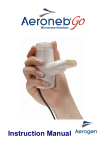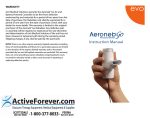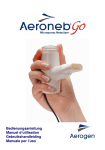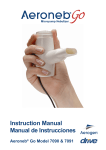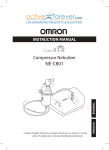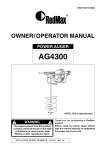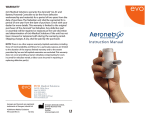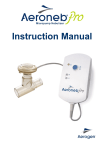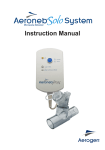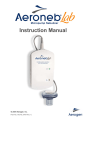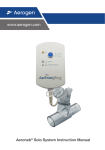Download Aeroneb Go Instruction manual
Transcript
Instruction Manual Table of Contents Introduction........................................................ 1 Important Safeguards........................................ 2 Warranty............................................................ 5 Classifications and Markings............................. 6 Aeroneb® Go System Parts............................... 7 Unit Assembly and Usage................................. 7 Prior to Assembly.............................................. 7 Assembly/Functional Test.................................. 8 How to Operate the Aeroneb® Go Nebulizer..... 9 Cleaning and Storing Your Aeroneb® Go......... 11 Troubleshooting Guide.................................... 14 Electromagnetic Susceptibility......................... 15 Specifications.................................................. 17 Performance.................................................... 18 Replacement Parts and Accessories............... 20 Appendix 1: EMC tables.................................. 21 This page has been intentionally left blank INTRODUCTION Be sure to read these instructions fully before use. Thank you for purchasing the Aeroneb® Go Nebulizer. Certain conditions such as asthma, COPD (chronic obstructive pulmonary disease) and cystic fibrosis require that prescribed liquid medication be turned into a fine mist, called an aerosol, and then inhaled into the lungs. The Aeroneb® Go turns liquid medication into an aerosol, which you can then inhale through a mouthpiece or an aerosol mask into your lungs. The Aeroneb® Go uses the unique OnQ™ Aerosol Generator, which is unlike any other nebulizer technology available. When you turn on your nebulizer, OnQ pumps liquid through tiny holes in a wafer-thin metal plate to create a soft mist aerosol. The Aeroneb® Go, for use by paediatric and adult patients, is intended to aerosolize physician-prescribed solutions for inhalation that are approved for use with a general-purpose nebulizer. Designed with your needs in mind, the Aeroneb® Go is portable, lightweight, compact and silent. The control module operates with three (3) “AA” disposable or rechargeable batteries (not included), or can alternatively be powered by the AC/DC adapter. 1 IMPORTANT SAFEGUARDS When you use electrical products, always follow basic safety precautions. As with any electrical device take particular care around children. READ ALL WARNINGS AND INSTRUCTIONS BEFORE YOU USE YOUR NEBULIZER WARNING: If this product is being used to treat a life threatening condition, a backup device is necessary. 2 • As with any electronic device, this product may become unusable due to an electrical outage, battery depletion, or mechanical failure. We recommend that you have spare batteries and have a backup device available to you. • The AC/DC adapter does not charge batteries. • If you are using batteries and the green light is flashing, your batteries are low. You may finish your treatment and then change (or replace and recharge) the three “AA” batteries immediately. • Do not share your Aeroneb® Go Nebulizer with others. It is intended for use by a single user. If more than one person uses it, there is a risk of spreading infectious illness. • As with all electronic devices, it is recommended that the product is unplugged when not in use. • Adult supervision is required when this product is used by children and individuals who require special assistance. • Use this product only for physician-prescribed solutions for inhalation as described in this manual. WARNINGS CONTINUED: • Do not use components or attachments that are not recommended by Aerogen. Refer to the Replacement Parts and Accessories section in this manual (page 20). • Never operate this product if any of the parts are not working properly or have been damaged. • Do not use the Aeroneb® Go Nebulizer in the presence of a flammable anaesthetic mixture with air, oxygen or nitrous oxide. As with any electrical equipment, take care when using the device in a potentially oxygen enriched environment. • Do not use the Aeroneb® Go Nebulizer with anaesthetic breathing systems or lung ventilator breathing systems. • Do not place or drop this product into water or any liquid when it is plugged into a power source. • Keep this product and cords away from heated surfaces. • Be sure the device has been properly cleaned before use to avoid possible contamination. • If after proper cleaning it takes longer than 12 minutes to deliver 3 mL of normal saline (0.9%), the Nebulizer Unit should be replaced. • The user should ensure that exhaled medication is directed away from bystanders. • Do not microwave any parts. • By connecting the AC/DC adapter to the Aeroneb® Go Control Module, the Aeroneb® Go Control Module and batteries are not being charged. • As with any cables keep all cables tidy to avoid tripping or strangulation hazards and take particular care around children. 3 WARNINGS CONTINUED: 4 • Do not nebulize alcohol-based drugs in an oxygen-rich/ high pressure environment. • In event of loss of mains power, remove the AC/DC cable from the control module and operate with batteries (refer to page 9). • Never clean your Nebulizer Unit with solvents, chemicals, alcohol or abrasive cleaners. • Do not use brushes, sharp tools or abrasive cloths that could scratch or damage the surfaces. • Do not clean parts in a dishwasher. • Store your Aeroneb® Go in the carrying case. • Do not store the Aeroneb® Go in a location where it is exposed to direct sunlight, extreme heat or cold, dust or water. Store out of reach of children. • Follow local laws and recycling plans regarding disposal or recycling of components, batteries and packaging. • Before storing your Aeroneb® Go for an extended period, remove the batteries from the Aeroneb® Go Control Module and store them separately. If you do not take the batteries out, they may leak and cause your nebulizer to stop working. WARRANTY The Aeroneb® Go Control Module and AC/DC Adapter are warranted for a period of two years from the date of purchase against defects in manufacturing. The Aeroneb® Go nebulizer unit is warranted for one year from date of purchase against defects in manufacturing. All warranties are based on typical usage. The life of the Aeroneb® Go nebulizer unit has been validated for use for 100 disinfecting treatments (boiling or baby bottle steam steriliser). This is based on a minimum of one year typical usage profile of 2 treatments per day and two disinfecting treatments per week. The user should note that any use in excess if this may result in reduced life of the product. 5 CLASSIFICATIONS AND MARKINGS The symbols that appear on the Aeroneb® Go Nebulizer and its accessories are described in the table below: Symbol Meaning Attention, consult accompanying documents Class II equipment per IEC/EN 60601-1 Type BF equipment per IEC/EN 60601-1. This label applies to Aeroneb® Go nebulizer unit only US Classified by TUV with respect to electric shock, fire and mechanical hazards SN Serial number REF Model number Manufacturer Input Output DC Voltage AC Voltage Power On/Off Fragile – Handle with care Keep Dry +60 oC –20 C o 0050 Transient storage temperature limits: -20°C to 60°C This device complies with the requirements of the Medical Devices Directive (93/42/EEC) Consult Instructions for Use 6 AERONEB® GO SYSTEM PARTS: Medication Cup Cap Mouthpiece Cable Nebulizer body Base Control Module AC/DC Adapter* Mask Adapters *Available with complete Aeroneb® Go System UNIT ASSEMBLY AND USAGE NOTE: Clean all parts of your Aeroneb® Go Nebulizer (described on page 11) before first use, after each use, or after extended storage. PRIOR TO ASSEMBLY: Check all parts for visible damage. Replace any damaged parts before you use the Aeroneb® Go. In the case of missing parts, malfunction or damage, contact your local Aeroneb® Go representative or equipment supplier. 7 ASSEMBLY/FUNCTIONAL TEST 1. Connect the Medication Cup to the Nebulizer Body by lining up the notches on the medication cup and nebulizer body. NOTE: Ensure the Aeroneb Go handset is not connected to the controller when adding medication to the medication cup. 2. Insert the nebulizer cable into the back of the nebulizer unit. 3. Add Aeroneb® Go base to the bottom of the handset. 4. Fill the Medication Cup with the prescribed nebulizer medication. Never pour more than 6 mL into the cup. The continuous line on the inside surface of the cup indicates the maximum filling level. CAUTION: To avoid damage to the nebulizer unit, do not use a syringe with needle. 5. Place the Cap on Medication Cup. 6. Attach Mouthpiece or Mask Connector and mask to Nebulizer Body. 8 HOW TO OPERATE THE AERONEB® GO NEBULIZER 3 x AA LR6 1. Turn the Aeroneb® Go Control Module upside down. Slide the battery cover in the direction of the arrow to remove the lid. Put in three (3) “AA” batteries (not included). Replace the cover on the Control Module and slide the cover until it locks in place. You can expect at least three (3) hours of operation from a new set of disposable batteries, (up to five (5) hours from high performance batteries). 2. Connect the nebulizer cable to the Aeroneb® Go Control Module, indicated by the Output symbol ( ). 3. Turn on the unit by pressing the “On/Off” button on the Control Module. You will see a green light on the Control Module light up. 3 x AA LR6 4. Visually verify that aerosol is coming out of the mouthpiece or mask to indicate that the device is functioning properly. NOTE: Do not cover the ventilation holes during use. 9 5. Alternatively, you can power the device by using the AC/DC Adapter if provided (refer page 7). Plug the AC/DC adapter into a standard AC electrical outlet, a green light on the adapter indicates that the AC/DC adapter is turned on. 6. Plug the AC/DC cable into the Control Module, indicated by the DC Voltage Symbol ( ). NOTE: The AC/DC adapter does not charge batteries. 7. Press the “On/Off” button and visually verify that aerosol is coming out of the mouthpiece or mask to indicate that the device is functioning properly. 8. Place the mouthpiece between your teeth, with your lips firmly sealed around the mouthpiece. If you use an aerosol mask, place the mask over your mouth and nose. Breathe in and out slowly through your mouth until aerosol formation stops. NOTE: Aerosol mask is not provided. Do not cover ventilation holes. 9. To turn off nebulizer, press the “On/Off” button on the Control Module. PAGE 10 10 CLEANING AND STORING YOUR AERONEB® GO AFTER EVERY USE: Disconnect the control module before you take the nebulizer apart to rinse it. 1. Rinse the Nebulizer Unit (Medication Cup, Nebulizer Body, Base and Mouthpiece or Mask Adapter) under running hot tap water after every use. 2. Shake off excess water, and allow parts to fully air dry on a clean, dry towel, out of the reach of children. 3. Make certain that all cleaned parts are completely dry before you store or use them. DAILY: Disconnect the power source before you take the nebulizer apart to clean it. 1. Wash the Nebulizer Unit (Medication Cup and Cap, Nebulizer Body, Base and Mouthpiece or Mask Adapter) by hand in a solution of warm water and mild liquid dishwashing soap. Use soap intended only for washing dishes by hand. Do not use dishwasher detergent. Do not leave parts soaking. 2. Rinse all pieces thoroughly under running hot tap water. Make sure that no soap is left on any of the parts. 3. Shake off excess water, and allow parts to fully air dry on a clean, dry towel, out of the reach of children. 4. Make certain that all cleaned parts are completely dry before you store or use them. 11 OPTIONAL DISINFECTION: If you would like to disinfect your Aeroneb® Go Nebulizer, you may choose one of the following two options; Boiling or Vinegar Solution. 1. BOILING: i. ii. iii. iv. v. vi. Rinse the Nebulizer Unit (Medication Cup, Nebulizer Body, Base and Mouthpiece or Mask Adapter) under running hot tap water after every use. Shake off excess water, and allow parts to fully air dry on a clean, dry towel, out of the reach of children. Bring a saucepan of DISTILLED water to the boil and allow it to continue to boil. NOTE: Using regular tap water to boil the nebulizer unit will greatly reduce the life of the nebulizer unit. Carefully immerse the Nebulizer Unit in the boiling water. Leave the nebulizer immersed in the boiling water for a maximum of twenty (20) minutes. Carefully remove the nebulizer from the boiling water and shake off the excess water. Allow parts to fully air dry on a clean, dry towel, out of the reach of children. Make certain that all parts are completely dry before you store or use them. Similarly, the Nebulizer Unit may be steam disinfected in a standard baby bottle steam sterilizer for fifteen (15) minutes. Refer to manufacturers instructions. 12 OPTIONAL DISINFECTION 2. VINEGAR SOLUTION: i. ii. iii. iv. v. vi. vii. Rinse the Nebulizer Unit (Medication Cup, Nebulizer Body, Base and Mouthpiece or Mask Adapter) under running hot tap water after every use. Shake off excess water, and allow parts to fully air dry on a clean, dry towel, out of the reach of children. Fill a container with a mixture of three (3) parts hot water to one (1) part white distilled vinegar. Soak the Nebulizer Unit Parts (Medication Cup and Cap, Nebulizer Body, and Mouthpiece or Mask Adapter) in the solution for thirty (30) minutes. Rinse all pieces thoroughly under running hot tap water. Shake off excess water, and allow parts to air dry on a clean, dry towel, out of the reach of children. Make certain that all disinfected parts are completely dry before you store or use them. Cleaning of Control Module, Cable, AC/DC Adapter: Wipe with a clean cloth dampened with warm water and mild liquid detergent. • Do not immerse in liquid. • Do not use abrasive or sharp tools. • Do not spray liquid directly onto the control module. • Do not immerse control module in liquid. 13 TROUBLESHOOTING GUIDE If you have difficulty operating your Aeroneb® Go, check the following points: Problem Check Remedy No visible aerosol when using batteries Check that the batteries are inserted correctly. Using the markings under each battery location, place each battery in the Control Module housing. Match (+) and (-). Check to see if the low battery power light is flashing. Replace the batteries or use the AC/DC Adapter. Check that the Control Module cable is connected properly to the nebulizer and to the Control Module. Connect the cable properly to the nebulizer and the Control Module (Refer to page 8). Check that the AC/DC Adapter is plugged correctly into a working AC outlet and the green light is on the AC/DC Adapter. Insert the plug into a working outlet and verify that the green light on the controller is lit (Refer to page 10). Check that the AC/DC Adapter cable is connected properly to the Control Module. Connect the AC/DC Adapter cable properly to the Control Module (Refer to page 10). No visible aerosol when using AC/DC adapter 14 Problem No visible aerosol when power source is functioning Check Remedy Check that the AC/DC Adapter is not faulty. Try to operate the Control Module by using batteries instead of the AC/DC Adapter. If the Control Module functions properly with batteries but not with the AC/DC adapter, replace the AC/DC Adapter. Check that there is medication in the Medication Cup. Fill the Medication Cup with prescribed medication. Check that the nebulizer has been properly cleaned. Clean the Aeroneb® Go. Refer to page 11. If above remedies do not work, call your local supplier. ELECTROMAGNETIC SUSCEPTIBILITY This device meets the requirements of IEC/EN60601‑1‑2 which describes requirements for electromagnetic compatibility (EMC) of medical devices. This includes immunity to radio frequency electric fields and electrostatic discharge, in addition to the other applicable requirements of the standard. Compliance with EMC standards does not mean a device has total immunity; certain devices (cellular phones, pagers, etc.) can interrupt operation if they are used near medical equipment. 15 WARNINGS: • Only use the Aeroneb® Go nebulizer with components specified in the Instructions for Use. Use of the Aeroneb® Go nebulizer with components other than those specified in the Instructions for Use may result in increased emissions or decreased immunity of the Aeroneb® Go nebulizer system. • Do not use the Aeroneb® Go adjacent to or stacked with other equipment. If adjacent or stacked use is necessary, the device should be observed to verify normal operation in this configuration. • The Aeroneb® Go needs special precautions regarding electromagnetic compatibility (“EMC”) and must be installed and put into service according to the EMC information provided in the Instructions for Use. • Portable and mobile radio frequency (“RF”) communication devices can disrupt medical electrical equipment. Refer to Appendix 1 for EMC Tables as per IEC/EN 60601-1-2 16 SPECIFICATIONS Physical Aeroneb Go nebulizer unit (assembled): 40 x 105 x 95 mm Aeroneb Go Control Module: 70 x 110 x 32 mm AC/DC adapter: 74 (H) x 72 (D) x 49 (L) mm Aeroneb Go Nebulizer Unit: 65 g Aeroneb Go Control Module with batteries: 260 g AC/DC Adapter: 100 g Medication Cup capacity: Maximum of 6 mL Environmental Recommended Operating Environment: Temperature range: 5°C to +45°C (+41°F to +113°F) Atmospheric pressure: 450 to 1100 mBars Humidity: up to 95% relative humidity Noise Level: <35 dB at 0.3 m distance Recommended Storage & Transport Environment: Transient temperature range: -20°C to +60°C (-4°F to +140°F) Atmospheric pressure: 450 to 1100 mBars Humidity: up to 95% relative humidity 17 PERFORMANCE: Aerosol flow rate: > 0.3 mL/min Average tested flow rate: 0.4 mL/min Particle Size: As measured with the Andersen Cascade Impactor: - - Specification Range: 1-5 μm. Average Tested: 3.1 μm. As measured with the Marple 298 Cascade Impactor: - - Specification Range: 1.5-6.2 μm. Average Tested: 3.9 μm. As per EN 13544-1: - Aerosol output rate: 0.25 mL/min - Aerosol Output: 0.86 mL emitted of 2.0 mL dose - Residual Volume: <0.1 mL for a 3 mL dose Performance may vary depending on the type of drug and nebulizer unit used. For additional information contact Aerogen or your drug supplier. The temperature of the medication will not rise more than 10°C (18°F) above ambient temperature during normal use. For additional information contact Aerogen or your drug supplier. 18 Representative particle size distribution graph for Albuterol as per EN13544-1 is shown below: Cumulative Mass (%) 100.0 50.0 0.0 0.1 1 10100 Aerodynamic Size (µm) Power Power Source: Aeroneb Go Control Module - 4.5 VDC (3 “AA” disposable or rechargeable batteries), 350 mA. AC/DC Adapter: 100-240 VAC, 5 VDC, 315 mA, 50-60 Hz. Power Consumption: Less than 2 watts (nebulizing) Patient Isolation: Control module circuitry provides 4 kilovolt (kV) patient isolation and complies with IEC/EN 60601-1 19 REPLACEMENT PARTS AND ACCESSORIES: PART Aeroneb® Go System Medication Cup Cap Aeroneb® Go Handset Mouthpiece Handset Base (pack of 10) AC/DC Adapter* Control Module Control Module Cable Mask Adapter (22 mm M) Mask Adapter (22 mm F) Carrying Case Instruction Manual* REORDER NUMBER AG-AG4200-XX* AG-AG3010 AG-AG4300 AG-AG3040 AG-AG4030 AG-AG3410-XX* AG-AG3060 AG-AG4070 AG-AG3080 AG-AG3090 AG-AG3110 AG-AG4120-XX* *Contact your local supplier for reorder number specific for your geographical region. To order replacement parts or accessories, contact your local supplier. If you have any questions or problems regarding your Aeroneb® Go nebulizer unit, call your local supplier. 20 Appendix 1 EMC tables: The following Tables are provided in accordance with IEC/ EN 60601-1-2: Guidance and manufacturer’s declaration – electromagnetic emissions The Aeroneb Go nebulizer system is intended for use in the electromagnetic environment specified below. The customer or the user of the Aeroneb Go nebulizer system should assure that it is used in such an environment. Emissions test Compliance RF Emissions CISPR 11 Group 1 RF Emissions CISPR 11 Class B Harmonic emissions IEC 61000‑3‑2 Not Applicable Voltage fluctuations/ flicker emissions IEC 61000‑3‑3 Not Applicable Electromagnetic environment – guidance The Aeroneb Go nebulizer system uses RF energy only for its internal function. Therefore, its RF emissions are very low and are not likely to cause any interference in nearby electronic equipment. The Aeroneb Go nebulizer system is suitable for use in all establishments, including domestic establishments and those directly connected to the public low voltage power supply network that supplies buildings used for domestic purposes. 21 Recommended separation distances between portable and mobile RF communication equipment and the Aeroneb Go The Aeroneb Go nebulizer system is intended for use in the electromagnetic environment in which radiated RF disturbances are controlled. The customer or the user of the Aeroneb Go can help prevent electromagnetic interference by maintaining a minimum distance between port and mobile RF communications equipment (transmitters) and the Aeroneb Go nebulizer system as recommended below, according to the maximum output power of the communications equipment. Rated maximum output power of transmitter W Separation distance according to frequency of transmitter m 150 kHz to 80 MHz 80 MHz to 800 MHz 800 MHz to 2.5 GHz d = [1.17] √P d = [1.17] √P d = [2.33] √P 0.01 0.12 0.12 0.23 0.1 0.37 0.37 0.75 1 1.17 1.17 2.33 10 3.70 3.70 7.36 100 11.70 11.70 23.30 For transmitters rated at a maximum output power not listed above, the recommended separation distance d in metres (m) can be estimated using the equation applicable to the frequency of the transmitter, where P is the maximum output power rating of the transmitter in watts (w) according to the transmitter manufacturer. NOTE 1 At 80 MHz and 800 MHz, the separation distance for the higher frequency range applies. NOTE 2 These guidelines may not apply in all situations. Electromagnetic propagation is affected by absorption and reflection from structures, objects and people. Guidance and manufacturer’s declaration – electromagnetic immunity The Aeroneb Go nebulizer system is intended for use in the electromagnetic environment specified below. The customer or the user of the Aeroneb Go should assure that it is used in such an environment. Immunity test IEC/EN 60601 Test level Compliance level Electrostatic discharge (ESD) ±6 kV contact ±6 kV contact IEC 61000‑4‑2 ±8 kV air ±8 kV air Electrical fast Transient/burst ±2 kV for power supply lines ±2 kV for power supply lines IEC 61000‑4‑4 ±1 kV for input/ output lines ±1 kV for input/ output lines Surge ±1 kV differential mode ±1 kV differential mode IEC 61000‑4‑5 ±2 kV common mode ±2 kV common mode Voltage dips, short interruptions and voltage variations on power supply input lines <5% Ut (>95% dip in Ut) for 0.5 cycle <5% Ut (>95% dip in Ut) for 0.5 cycle 40% Ut (60% dip in Ut) for 5 cycles 40% Ut (60% dip in Ut) for 5 cycles 70% Ut (30% dip in Ut) for 25 cycles 70% Ut (30% dip in Ut) for 25 cycles <5% Ut (>95% dip in Ut) for 5 sec <5% Ut (>95% dip in Ut) for 5 sec IEC 61000‑4‑11 Electromagnetic environment – guidance Floors should be wood, concrete or ceramic tile. If floors are covered with synthetic material, the relative humidity should be at least 30%. Mains power quality should be that of a typical commercial or hospital environment. Mains power quality should be that of a typical commercial or hospital environment. Mains power quality should be that of a typical commercial or hospital environment. If the user of the Aeroneb Go requires continued operation during power mains interruption, it is recommended that the Aeroneb Go be powered from an uninterruptible power supply or battery. Immunity test Power frequency (50/60 Hz) Magnetic field IEC/EN 60601 Test level 3 A/m Compliance level 3 A/m IEC 61000‑4‑8 Electromagnetic environment – guidance Power frequency magnetic fields should be at levels characteristic of a typical location in a typical commercial or hospital environment. Note: Ut is the a.c. mains voltage prior to application of the test level. Guidance and manufacturer’s declaration – electromagnetic immunity The Aeroneb Go nebulizer system is intended for use in the electromagnetic environment specified below. The customer or the user of the Aeroneb Go should assure that it is used in such an environment. Immunity test IEC/EN 60601 Compliance Test level level Conducted RF 3 Vrms IEC 61000‑4‑6 150 kHz to 80 MHz [3]V Electromagnetic environment – guidance Portable and mobile RF communications equipment should be used no closer to any part of the Aeroneb Go, including cables, than the recommended separation distance calculated from the equation applicable to the frequency of the transmitter. Recommended separation distance d = [1.17] √P d = [1.17] √P... 80 MHz to 800 MHz Radiated RF 3 Vrms IEC 61000‑4‑3 80 MHz to 2.5 GHz [3]V d = [2.33] √P... 800 MHz to 2.5 GHz where P is the maximum output power rating of the transmitter in Watts (W) according to the transmitter manufacturer and d is the recommended separation distance in metres (m). Guidance and manufacturer’s declaration – electromagnetic immunity The Aeroneb Go nebulizer system is intended for use in the electromagnetic environment specified below. The customer or the user of the Aeroneb Go should assure that it is used in such an environment. Immunity test IEC/EN 60601 Compliance Test level level Electromagnetic environment – guidance Field strengths from fixed RF transmitters, as determined by an electromagnetic site survey, ª should be less than the compliance level in each frequency range. b Interference may occur in the vicinity of equipment marked with the following symbol: Note 1: At 80 MHz and 800 MHz, the separation distance for the higher frequency range applies. Note 2: These guidelines may not apply in all situations. Electromagnetic propagation is affected by absorption and reflection from structures, objects and people. ª Field strengths from fixed transmitters, such as base stations for radio (cellular/cordless) telephones and land mobile radios, amateur radio, AM and FM radio broadcast and TV broadcast cannot be predicted theoretically with accuracy. To assess the electromagnetic environment due to fixed RF transmitters, an electromagnetic site survey should be considered. If the measured field strength in the location in which the Aeroneb Go is used exceeds the applicable RF compliance level above, the Aeroneb Go should be observed to verify normal operation. If abnormal performance is observed, additional measures may be necessary, such as re-orientating or relocating the Aeroneb Go nebulizer system. Over the frequency range 150 kHz to 80 MHz, field strengths should be less than [3]V/m b This page has been intentionally left blank Aerogen Limited, Galway Business Park, Dangan, Galway, Ireland. www.aerogen.com Ph: +353 91 540400 ©2013 Aerogen Limited AG-AG4120-EN Rev D 2013 Manufacturing no.: 30-553 Rev D 0050
































